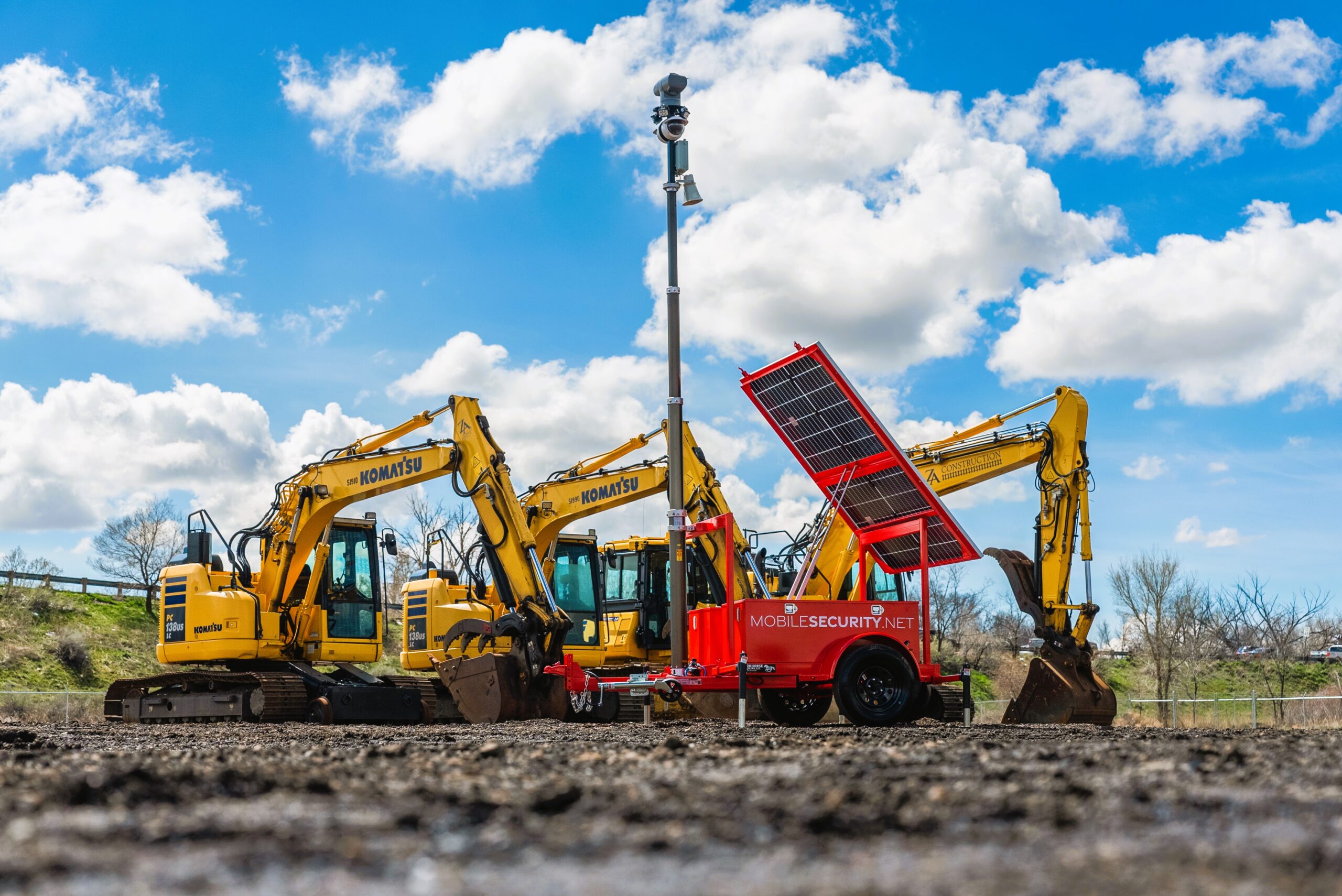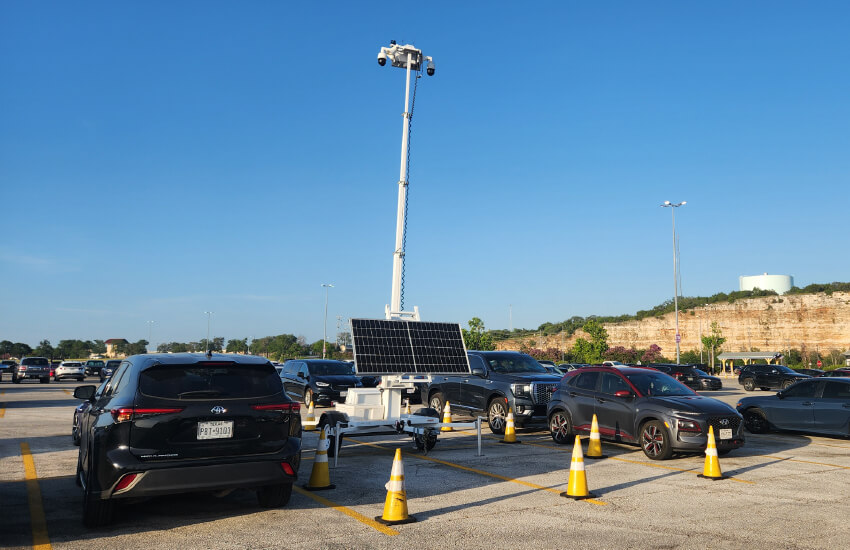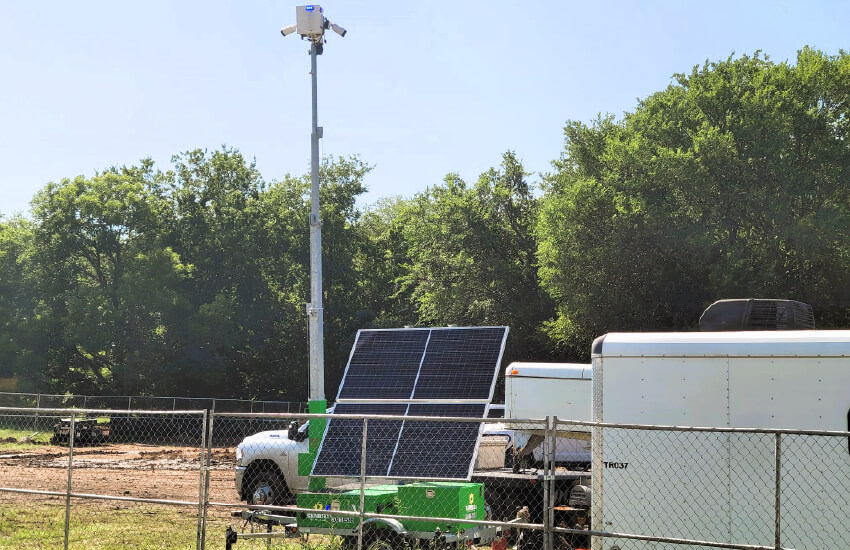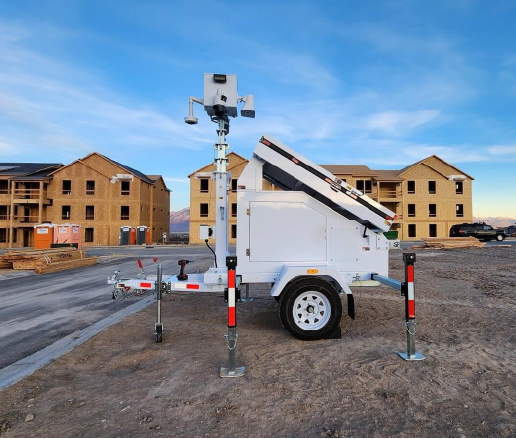by Nir Elron | April 9, 2024
The popularity of Video-Surveillance-as-a-Service (VSaaS) keeps growing. According to analysts’ reports, last year the VSaaS market reached the size of $ 3.5 billion and is expected to grow 18.5% annually until 2031. It is not surprising: traditional video surveillance deployments imply much higher initial capital expenditures, involve more people and require more time to install, configure and maintain cameras and other equipment. However, costs may not be the only reason – and the example of mobile surveillance units demonstrates why enterprises view VSaaS as a better, or sometimes the only, option for securing their assets.
Mobile surveillance units (MSU) or mobile surveillance trailers are used to protect people and facilities from potential threats and can help build a security zone anywhere in the shortest time possible. The typical mobile surveillance unit includes a wheeled base with a solar panel, a battery and an adjustable mast with high-resolution cameras, floodlights, strobe lights and loudspeakers. It may also use thermal cameras, microphones, radar, GPS, and other sensors that detect and track movement or capture images and video.
Cellular connectivity is one of two staples of mobile surveillance units’ autonomy. By leveraging mobile networks and solar power, these devices can operate literally anywhere on the globe with no access to fixed communications or even an electric network. Essentially, cellular connection transmitting video data makes MSUs the most advanced and the most flexible physical security setup capable of off-grid operations. It provides the flexibility to monitor areas that were previously inaccessible and significantly expands the scope of surveillance applications, opening many usage scenarios, from ensuring safety at remote sites to setting up a full-scale video surveillance system anywhere in a matter of hours. Most of these scenarios are mission-critical use cases that require high availability and have high data consumption.
Once deployed, these autonomous units work in any environment, rarely need maintenance and involvement of additional personnel. For use cases that require the physical presence of security guards, mobile surveillance units can’t replace them on the ground; but in many cases, MSUs can be an enhancement to their abilities, to help them detect, react and investigate incidents sooner. Also, they can serve as a backup for existing fixed security cameras or complement traditional video surveillance systems where they have blind spots. Multiple units can be placed in a grid fashion to maximize site visibility.
There are also many use cases where mobile surveillance units are indispensable.

Outdoor Events
Whether it’s a rally in a big city square or an open-air music festival in the countryside, the security team needs a way to monitor the event and keep everyone safe. Technically, both cases can be challenging when it comes to setting up a video surveillance system. First and foremost, it requires a reliable power and connectivity source. Besides, laying miles of cables and deploying fixed cameras on poles or buildings can take too long and cost too much for a one-off occasion.
Using mobile surveillance units at outdoor events can significantly improve safety, helping security personnel to identify potential hazards, direct people to safer locations, prevent crime and investigate incidents. Relying on mobile networks instead of landline communications, they can be rapidly deployed, placed in strategic locations and moved if need be.
Critical Infrastructure and Assets Monitoring
Video surveillance is critical for monitoring assets and facilities in many industries, including energy, oil and gas, transportation, agriculture – and not only for workers’ safety. Problems such as cable theft cause annual losses that amount to billions of dollars, including the cost of replacing stolen cables, lost productivity, and damage to property. Oil and gas operators report a significant increase in oilfield theft – from crude oil in tank batteries to copper wiring, tools, pipes and vehicles – amounting to tens or hundreds of millions of dollars. In rural areas, there are gangs that target high-value farm machinery and GPS kits.
Protecting this critical infrastructure and assets can be challenging, as most often these facilities and equipment are at remote, isolated and off-grid locations. Cellular-enabled mobile surveillance units can help to address these challenges and set up an advanced security system literally in any spot that has mobile network coverage.
Construction Sites
Raw materials, tools, machinery, unfinished structures – there are a lot of objects that need to be safeguarded at any construction site. Video surveillance can also help improve workers’ safety and ensure that they follow occupational safety and health requirements. Sometimes it may be utilized to monitor the construction process. All these tasks can be complicated due to size, location, shifting perimeters of construction sites, limited access to fixed communications and even power grid. The dynamic nature of construction work can be an additional challenge. As walls rise and structures change, fixed cameras’ coverage may become limited, creating blind spots and leaving some areas vulnerable.
Autonomous MSUs can be a solution to all these challenges, providing video surveillance 24/7 even in remote locations without access to the power grid. They can be easily moved according to the changing needs of the security system.

Parking Lots
Parking lots at retail stores, schools, healthcare facilities, car dealerships and other facilities may present many security risks. Aside from car crimes, it is also one of the most common places people get attacked. Given the usual size of parking lots, it would take a lot of security personnel to ensure safety by patrolling. Setting up a video surveillance system can help, but laying down cables and mounting cameras is not an easy task both at an open parking lot and at a garage or underground parking. Besides, it is a dynamic environment with different areas that need to be monitored specifically at certain moments.
Cellular-connected video surveillance system that uses mobile surveillance units can solve the problem by providing the capability to quickly adjust to changing conditions, add or remove some MSUs if needed and always guarantee continuous monitoring.
Connectivity Requirements
However different in terms of conditions and locations, all MSU usage scenarios have similar connectivity requirements, since they have more to do with the demands of autonomy and video surveillance rather than with the specifics of a certain use case.
Coverage and Bandwidth
Stable connectivity is crucial for mobile surveillance units, therefore coverage is one of the major concerns. It’s very important that MSUs be able to connect to any provider’s cellular tower – not only because it may be the only available tower, but also because each mobile network may have weak spots. It should be taken into consideration that this may require contracting several operators providing connectivity services for every deployment.
Live video streaming requires a significant amount of bandwidth, especially for high-definition content. However, enterprises are dependant on a cellular connectivity provider to guarantee a robust and reliable connection. So at the contracting stage, it’s important to make sure there are no additional limitations such as throttling.
Latency
Latency is critical in any system that provides security services. Moreover, in the case of mission-critical applications, such as safety-related systems, it needs to be at the lowest level possible for them to be effective. With MSUs, latency will define how quickly security personnel can detect and react to an incident or prevent it. It should be noted though that actual latency would depend on the connectivity provider’s network architecture.
Compliance with Regulations
Enterprises may have problems with deploying security cameras, especially with cross-border deployments, because of local regulations. In many countries legislation stipulates certain restrictions on connectivity and data transfer, and it is important to comply with local data sovereignty and data protection regulations. In fact, one of the reasons for the growing popularity of VSaaS concept is that businesses can pass on some of their responsibility for that compliance to VSaaS providers.

Webbing’s Solution
Webbing offers a connectivity solution that ensures global access to reliable and high-quality internet, with low latency and the best of class coverage. It provides secure and continuous internet connection, delivering a streamlined, centralized, and scalable means of deploying, controlling and monitoring video surveillance units.
Our partner network of over 600 mobile operators worldwide guarantees global coverage without having to contract with multiple local carriers. It allows MSUs to roam on several carriers’ networks in every region, solving the problem of weak spots that any mobile network may have and ensuring full coverage and continuous connectivity for all surveillance units, even at remote locations.
Webbing’s eSIM solution allows for remote provisioning and a swap between multiple mobile carrier profiles without carrier integration, easily turning it into any operator’s SIM. This may be especially useful for customers that need to use a third-party carrier such as FirstNet for their projects. It also ensures failover connectivity with the option to fall back from a failing profile to a different profile without any need to communicate with a remote server. Webbing’s management portal provides a centralized way to manage eSIMs, as well as visibility into device data usage.
Webbing is a global connectivity provider, with a distributed full-core network with local breakouts, multiple network solution, and data server redundancy that can provide connectivity stability and low latency. As such, Webbing’s IoT network is well suited to support mission-critical, high-data consumption type of use cases. It allows our solutions to enable a whole range of different video surveillance scenarios, from lower consumption trigger-based cases generating 5 to 15 GB of data monthly to time-lapse applications that can go beyond 500 GB a month.
Our network supports all types of connectivity regulations, so it’s easy to comply with local and regional regulation requirements. Webbing can also seamlessly localize deployments utilizing Remote SIM Provisioning even in heavily regulated markets, such as Turkey.
Our solutions ensure the flexibility and scalability needed to deploy mobile surveillance units, providing the benefits of roaming with multiple carrier options in every country, and seamless transition between carriers, while maintaining low rates and low latency on a global scale with a single SIM.
Reach out to learn more about Webbing’s solutions.




